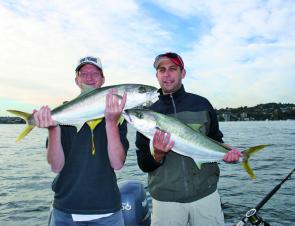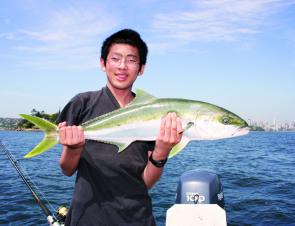After the water regularly dropped to a very low 13° it’s now up to 16° and this slight rise appears to have been enough to trigger the kings to show up in force, despite their normal minimum comfort level being 19°.
The fish are all upstream around Darling Harbour and Middle Harbour and average size is good at 70cm. It’s a great sign for the coming season.
Sydney Harbour kingies traditionally move in about October.
For some reason their distribution at this time is limited to The Spit and lower Middle Harbour region. They are usually a bigger run of fish than the average Summer specimens and range from 70cm to 120cm.
There normally are no visual or electronic signs of them; the only way you will know they are there is to fish for them.
They don’t come near the surface and they mostly hold under the marinas and the moorings, making them hard to find on the sounder. The major strongholds of arrow squid are in these areas and my bet is that this is why the kings are there, too.
If you go to the trouble to learn to catch squid, you will always catch a lot of kings and that is the only way I know to do it. If you go to the fish markets and buy very fresh squid you will catch a few kings – sometimes.
If you want to catch them on lures, most people must use the 6” or 9” soft stickbaits or saltwater flies. Poppers are occasionally OK for a few kings.
About Christmas time, the rats come in. These are the fish that swarm throughout the Harbour all Summer and Autumn
The first signs of their presence are on the surface. That time of year sees a lot of surface action with bonito, tailor and recently salmon on the lower Harbour. The kings get in on the act as well.
They are hard to catch at this time and your best bet is with a fly or a tiny stickbait. They are feeding on ‘eyes’ (tiny baitfish) and it’s hard to interest them in anything else.
Once they go off the ‘eyes’, they move in around the marker buoys and yacht moorings, usually in about late January. Now they are much less selective and this is the time to catch large numbers of them on squid, stickbaits and flies.
You can see the fish and mark them on the sounder. They range from 50cm to 70cm, are fired up and quite easy to catch.
Kingies mostly hold from mid-water down, so obviously that is a good place to present your bait.
High tide and the first two hours of the run out, early morning and late afternoon are when you will find them really feeding and these also are good times to catch squid.
You wont have to worry too much about tides or time of day it you have quality bait and drop it in the right spot.
Kings are easily turned on and then off again if you know what buttons to push. The worst thing you can do is to keep presenting in the same manner something that has been rejected.
A school of ‘following’ kings can be turned into a school of hungry kings by something as simple as changing the presentation angle. This applies to lures and bait.
If they follow a lure or show interest in a bait more than three times without taking it, don’t present it again.
Kings are the exact opposite to barra in this sense. Barra can be teased into striking but kings can be teased out of striking. They are stubborn and the more you shove it in their faces the more they’ll reject it
Change lure size, let it sink, change presentation angle or, best of all go away, try another spot and come back in half an hour.
Big kingies like whole live squid but small ones don’t. Big kingies will just as happily take a squid head.
So, by using a squid head you will get lots of big and small kingies. But if you use live squid you will get fewer fish but they will be bigger on average.
A whole squid gut is an exceptionally good bait and it is also the best berley that you can use for kings.
It’s all about the guts. Use the guts, especially the ink, to entice the fish. You can burst the ink sac before you send the bait down or you can let the first king burst it for you.
The gut is always the first bait to go, which must mean it’s the best bait.
Strips of squid cut from the tube are good, particularly after the guts and heads have got the school in a frenzy. Rub it all in ink.
To turn on kings, surprise them. Rock up to a spot noisily. Throw your anchor with a big splash and then get all your baits out there quickly. Let the baits sink to the required depth and then rip them back in.
As soon as the anchor hits the water, they come straight over to see what is happening. The key is to not give them too much time to think about it; trick them into an impulse attack. Action excites them but not for long, so work quickly.
You also are better to have five or six baits in the water rather than just a few. Once again, this is more likely to excite them.
If you can’t handle six rods just take a few out of action once you have the fish on the bite.
One final but equally important tip is to fish with your reel in gear and with your normal fighting drag. Don’t feed kingies any line when they take your bait.
Once a take is felt, lower the rod tip and move with the fish. Once the rod reaches the water, it’s time to strike.
Reads: 1253
Despite water cooler than normal, the kingies have amped up.

A squid head appeals to all sizes of kings, from rats to greenbacks.

The link between kingfish and squid in Sydney Harbour is extremely strong.




